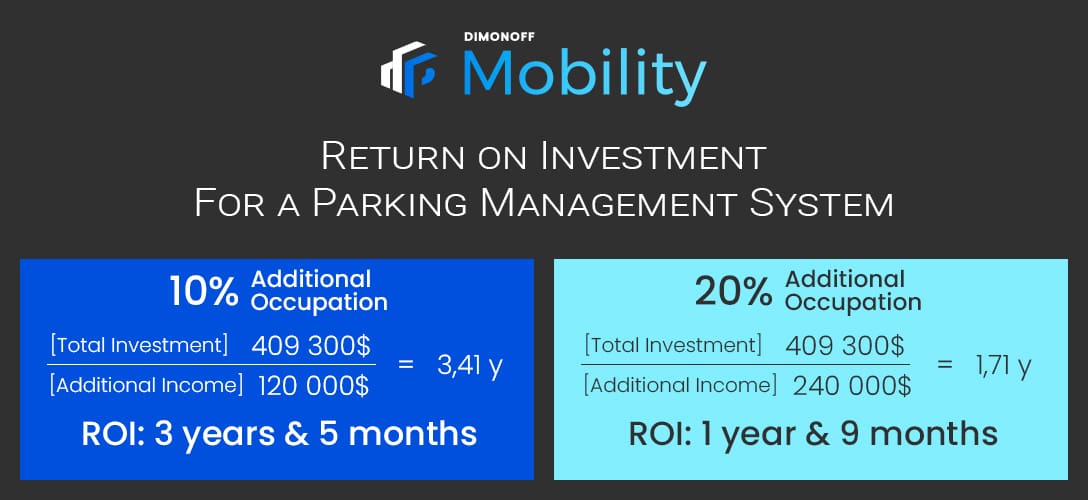Dimonoff is honoured to be named the 2025 Green Tech Award winner in the Smart City Lighting category by Digi International.
What is the Return on Investment for a Smart Parking System?
With the exponential growth of the number of cars in cities, the commercial sector and large companies are increasingly faced with parking problems. It is in this context that smart parking becomes the best technological option available for parking managers.
But first, how do these kinds of smart systems work? The main objective of a smart parking solution is to identify the presence (or absence) of a vehicle in a specific area or parking space with a high degree of accuracy. All this data is then collected, processed and analyzed by a central management platform and finally shared with users and parking managers.
By incorporating IoT into a smart parking management system, it is thus possible to extract value from your data to enhance your business offering, streamline your operations and maximize your revenue.
How Do Smart Parking Management Systems Pay for Themselves?
When we discuss smart parking management systems, it is not always obvious what the return on investment (ROI) really is. The cost and ease of installation as well as the data value generated are major requirements to consider. Some of the revenue streams of a smart parking solution that provide a quick ROI include:
Direct revenue sources:
- Rental of unused spaces
- Increased enforcement. Today less than 8% of parking violations are enforced
Indirect revenue sources:
- Increase of 20% in new customers for commercial areas
- Growth in revenue from paid parking
Given the complexity of analyzing ROI on indirect revenue sources since the context of each parking lot is different, we will focus on a ROI analysis considering only direct revenue sources. Nevertheless, we can say that on indirect revenue sources, a smart parking solution makes it much easier for drivers to find parking, which contributes to a better customer experience and a better turnover of a parking lot. In addition, this type of system also improves the attractiveness of commercial sectors, through better predictability of parking availability and, consequently, a better turnover of visits.
Let’s take the example of a parking lot located in a commercial area that is not equipped with a smart parking solution. Knowing that drivers abandon the parking site on average after 5 minutes of searching for a parking spot, its total capacity would be limited to about 90%. In the opposite case, this same parking lot equipped with a smart parking solution would maximize its parking turnover and consequently the retention of its customers. It could therefore welcome up to 10% more customers, thus generating more revenue (especially if the parking lot is located in a commercial area).
Example of a Return on Investment for a Smart Parking Solution
To demonstrate the return on investment of a smart parking solution, let’s take a 1,000 space parking lot that already has an annual occupancy rate of 70% as an example. First, we need to calculate all the investment costs to be expected (all costs in this example are calculated in Canadian dollars):
Investment Costs
1. Equipment costs calculation:
In this specific example, we would need 500 sensors (one sensor covers two spots), 1 gateway and 10 dynamic display panels. Here are the costs for each piece of equipment needed:
- Sensors: $650 x 500 = $325,000
- Gateways: $1,500 x 1 = $1,500
- Dynamic Display Panels: $1,900 x 10 = $19,000
Total equipment costs: $345,500 ($345.50/parking spot)
2. Recurring operating costs calculation:
These are the costs for accessing the data management and valuation platform. For our example, we obtain a recurring cost of $1/spot/month:
- 1$ x 1,000 spots x 12 months = 12,000$ / year
Total annual recurring costs: $12,500 ($12/parking spot)
3. Installation costs calculation:
All costs in this example are simply estimates as installation costs can vary greatly depending on the supplier chosen and the configuration of each project.
- Indoor sensors installation (including ceiling rails): $75 x 500 = $37,500
- Gateway installation: $1,300 x 1 = $1,300
- Dynamic Display Panels installation: $1,300 x 10 = $13,000
Total installation costs: $51,800 ($51.80/parking spot)
$345,500 + $12,000 + $51,800 = $409,300 ($409.30/parking spot)
Additional Sources of Income
In our example, we set the parking’s annual occupancy rate at 70%. However, by renting out unused parking spaces (30% of the parking lot) on a monthly basis, managers can increase their occupancy rates as well as their operational revenues.
By choosing a $100/month rental model for unused spaces and increasing the occupancy rate to 80% or 90%, here is the additional annual revenue that your smart parking lot could generate:
Additional revenue:
100 spaces x $100/month x 12 months = $120,000
Additional revenue:
200 spaces x $100/month x 12 months = $240,000
Return on Investment

As you can see, even if we are more conservative and allocate to monthly rentals only 10% of the fleet (to reach an occupancy rate of 80%), we would have a return on investment of 3 years and 5 months. On the other hand, if we allocate 20% of our parking to monthly rentals, the occupancy rate would reach 90% for a much faster return on investment, i.e. in 1 year and 9 months.
We see then that even considering only one additional source of revenue (in this case monthly parking rentals), a smart parking solution is an investment to consider for any parking asset owner or manager.
Dimonoff’s Indoor Smart Parking Management System
For more than 15 years, Dimonoff has been creating solutions that make cities, campuses, and businesses smarter. In this vision of ecological, economic and experiential efficiency, we have created Dimonoff Mobility, a complete smart parking management solution which is composed of three basic elements that make up its foundation:
- MPS Sensors allow monitoring the status of parking lots in any type of environment and for any kind of installation, be it on walls, ceilings or integrated in urban infrastructure.
- M1 Gateways allow communication between all sensors, whether they are MPS sensors or other third-party sensors from the market, including non-parking sensors.
- Spatium Smart Parking Management Platform allows parking managers to better understand, manage and control their parking lots.
Compared to the competition, our sensors do not require any wiring (neither electrical nor communicational), which significantly reduces installation and management costs.
Once installed, our smart parking system provides drivers with real-time information on available parking spaces and facilitates their parking process. As an open solution, it can be combined with third-party equipment such as payment terminals, access barriers, license plate recognition cameras or dynamic display panels. Our mobility solution is also integrated into the overall Dimonoff solutions ecosystem to make it more complete and more efficient.
Author: Jostran Lamontagne
Vice President Sales & Marketing




















